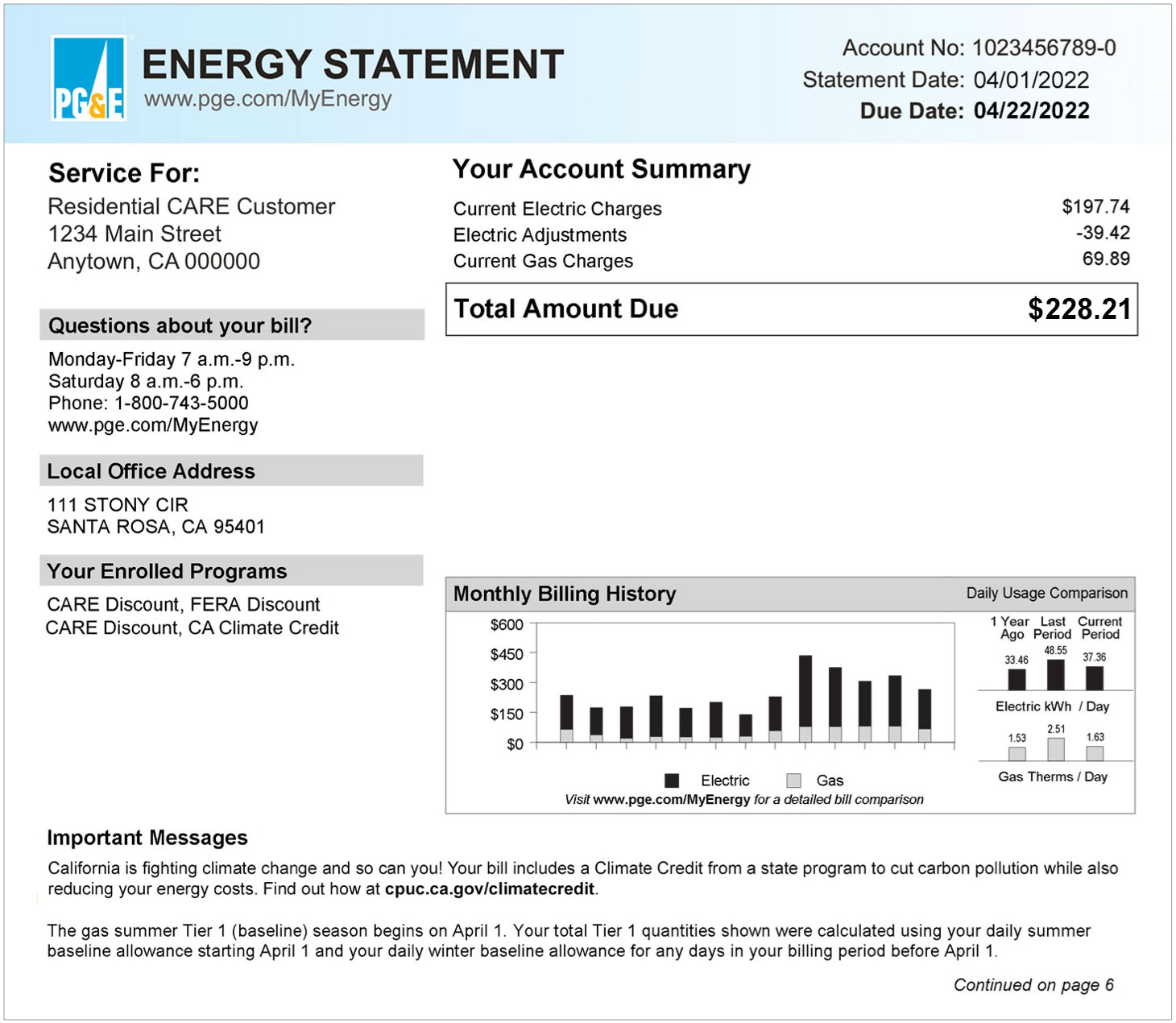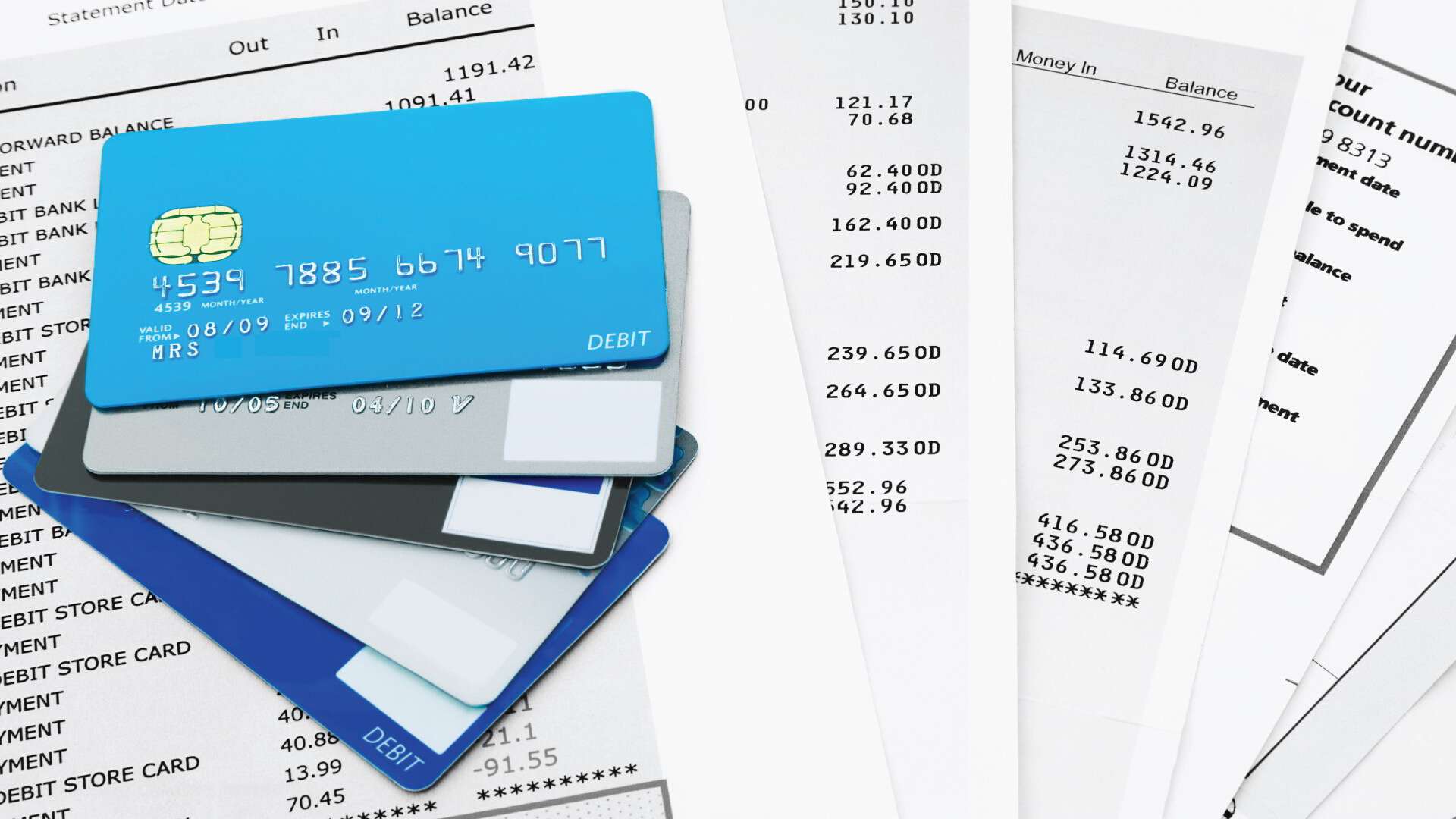

Finance
What Is Generation Credit On PGE Bill
Published: January 11, 2024
Learn what generation credit on your PGE bill means and how it impacts your finances. Discover how this factor can affect your energy costs and billing situation.
(Many of the links in this article redirect to a specific reviewed product. Your purchase of these products through affiliate links helps to generate commission for LiveWell, at no extra cost. Learn more)
Table of Contents
Introduction
Welcome to the world of utility bills, where understanding the various components can sometimes feel like decoding a complex puzzle. One such component that many people find confusing is the “Generation Credit” on their PGE (Pacific Gas and Electric) bill. In this article, we will demystify this term and provide a comprehensive overview of what Generation Credit is and how it impacts your PGE bill.
PGE bills are divided into different sections, each representing a specific aspect of your energy consumption and charges. Understanding the structure of the bill is crucial to gaining a clear picture of your energy usage and costs. One important section to pay attention to is the “Generation Credit,” a term that refers to a credit that customers may receive for excess energy generated by their renewable energy systems, such as solar panels.
The purpose of the Generation Credit is to encourage and incentivize the adoption of renewable energy sources by providing financial benefits to those who generate their own electricity. This not only helps individuals reduce their carbon footprint but also contributes to the overall goal of transitioning to a more sustainable and cleaner energy future.
Throughout this article, we will explore the intricacies of Generation Credit – how it is calculated, the factors that can affect its value, and the benefits it offers to PGE customers. So, let’s dive in and unravel the mystery behind the Generation Credit on your PGE bill.
Understanding the PGE Bill Structure
Before delving into the specifics of Generation Credit, it’s important to have a basic understanding of the structure of your PGE bill. Every PGE bill consists of several sections, each representing different aspects of your energy usage and charges. By familiarizing yourself with these sections, you can gain a clearer understanding of how the Generation Credit fits into the bigger picture.
The PGE bill typically consists of the following sections:
- Customer Information: This section contains your account details, including your name, address, and account number. It is important to review this information for accuracy.
- Electric Usage: This section provides an overview of your electricity consumption during the billing period. It includes important details such as the number of kilowatt-hours (kWh) consumed and the corresponding charges.
- Service Charges and Taxes: Here, you’ll find any additional charges and taxes associated with your energy usage. This can include delivery charges, regulatory fees, and local taxes.
- Generation Credit: This is the section specifically related to the Generation Credit. It provides details about any excess energy generated by your renewable energy system and the corresponding credit applied to your bill.
- Total Charges and Payments: This section summarizes all the charges on your bill, including your electricity usage, service charges, and taxes. It also displays any previous payments and the current balance.
By familiarizing yourself with these sections, you can navigate your PGE bill more effectively and better understand the impact of Generation Credit on your overall charges. Now, let’s take a closer look at what Generation Credit actually means and how it is calculated.
What is Generation Credit?
Generation Credit is a term used to describe the credit that customers receive on their PGE (Pacific Gas and Electric) bill for excess energy they generate through their renewable energy systems, such as solar panels. It is a way for PGE to incentivize and promote the adoption of clean and sustainable energy sources.
When you have a renewable energy system installed, such as solar panels, it produces electricity. In some cases, this renewable energy system may produce more electricity than you actually use in your home or business. The excess energy is then fed back into the grid, and PGE provides a credit on your bill for the value of this excess energy.
The Generation Credit is calculated based on the net excess generation (NEG). Net excess generation is the difference between the total energy produced by your renewable energy system and the total energy consumed by you during a billing period. If your system produces more energy than you consume, you will receive a credit for the excess generation.
It’s important to note that the Generation Credit is different from net metering, which is the process of crediting customers for the energy they produce and feed back into the grid. While net metering credits are used to offset the energy you consume from the grid, the Generation Credit represents the financial value of the excess energy that you contribute to the overall grid supply.
The Generation Credit not only helps you save money by offsetting your energy costs but also allows you to contribute to a more sustainable energy future by reducing your carbon footprint. The more excess energy you generate, the higher your Generation Credit will be, making it a win-win situation for both you and the environment.
Now that we have a basic understanding of Generation Credit, let’s explore how it is calculated and the factors that can affect its value.
How is Generation Credit Calculated?
The Generation Credit on your PGE (Pacific Gas and Electric) bill is calculated based on the net excess generation (NEG) of your renewable energy system. To understand how the Generation Credit is determined, let’s break down the calculation process:
- Total Energy Produced: The first step in calculating the Generation Credit is to determine the total energy produced by your renewable energy system during the billing period. This is typically measured in kilowatt-hours (kWh).
- Total Energy Consumed: Next, the total energy you consumed from the grid during the same billing period is measured. This is also measured in kilowatt-hours (kWh).
- Net Excess Generation (NEG): The NEG is calculated by subtracting the total energy consumed from the total energy produced. If your renewable energy system produced more energy than you consumed, the result will be a positive value, indicating excess generation.
- Generation Credit Value: The Generation Credit value is determined by multiplying the net excess generation (NEG) by a specific rate. This rate is typically set by PGE and represents the financial value assigned to each kilowatt-hour of excess energy you contribute to the grid.
It is important to note that the rate used to calculate the Generation Credit may vary based on factors such as the time of day, the day of the week, and the season. These variations help account for the fluctuating demand and supply of electricity throughout the day and year.
Once the Generation Credit is calculated, it is then applied as a credit to your PGE bill. This means that the value of your excess energy is subtracted from the total charges on your bill, reducing the amount you owe.
It’s worth mentioning that the Generation Credit is just one component of your PGE bill, and its value can vary from month to month depending on your energy production and consumption. It is essential to monitor your renewable energy system’s performance and keep track of your Generation Credit to fully understand its impact on your overall bill.
Now that we know how the Generation Credit is calculated, let’s explore the factors that can affect its value.
Factors Affecting Generation Credit
Several factors can influence the value of the Generation Credit on your PGE (Pacific Gas and Electric) bill. Understanding these factors can help you anticipate any changes in your Generation Credit and effectively manage your renewable energy system. Let’s take a look at the key factors that can affect the Generation Credit:
- Energy Production: The amount of energy your renewable energy system produces directly impacts your Generation Credit. The more energy your system generates, the higher the credit will be.
- Energy Consumption: Your energy usage plays a crucial role in determining the Generation Credit. If you consume less energy from the grid, there is a higher likelihood of generating excess energy and receiving a larger credit.
- Time of Generation: The time when you generate excess energy can affect the Generation Credit. Some utility companies offer different rates for electricity generated during peak and off-peak hours. Generating excess energy during off-peak hours may result in a higher credit value.
- Seasonal Variations: The amount of sunlight or wind available for your renewable energy system can vary throughout the year, resulting in fluctuations in energy production. Seasonal variations can impact the Generation Credit, as it is based on the net excess generation during the billing period.
- Rate Structure: PGE may have different rate structures and pricing tiers for energy consumption and credit calculation. Understanding the specific rate structure applicable to your account will help you anticipate the Generation Credit value accurately.
- Energy Storage: If you have an energy storage system, such as a battery, connected to your renewable energy system, it can impact the Generation Credit. By storing excess energy and using it during peak demand periods, you can maximize your credit value.
- Utility Policies: The policies and regulations set by PGE and the utility commission can also affect the Generation Credit. Changes in policies may impact the rate at which excess energy is valued and credited.
By considering these factors, you can optimize your renewable energy system’s performance, maximize your Generation Credit, and make informed decisions about your energy consumption. Understanding how these variables interact will help you take full advantage of the benefits of clean and sustainable energy generation.
Now that we’ve explored the factors affecting the Generation Credit, let’s delve into the benefits it offers to PGE customers.
Benefits of Generation Credit
The Generation Credit on your PGE (Pacific Gas and Electric) bill offers several benefits to customers who generate excess energy through their renewable energy systems. Let’s explore some of the key advantages of the Generation Credit:
- Reduced Energy Costs: One of the primary benefits of the Generation Credit is the opportunity to significantly reduce your energy costs. By generating excess energy and receiving a credit for it, you can offset a portion of your electricity expenses. This can lead to substantial savings in the long run.
- Financial Incentives: The Generation Credit provides a financial incentive for installing and maintaining renewable energy systems. It rewards customers who contribute to the overall energy grid by generating clean and sustainable electricity. The credit serves as an additional return on investment for the installation of solar panels or other renewable energy technologies.
- Environmental Sustainability: Generating your own clean energy through renewable sources significantly reduces your carbon footprint. By utilizing solar panels, wind turbines, or other eco-friendly technologies, you contribute to the global effort to combat climate change and promote environmental sustainability.
- Energy Independence: Generating your own electricity gives you a degree of energy independence. By relying less on the traditional energy grid, you become less vulnerable to fluctuations in energy prices and potential power outages. It provides a sense of self-sufficiency and resilience in the face of unforeseen circumstances.
- Supporting Renewable Energy Development: By participating in the Generation Credit program, you actively support the development and growth of renewable energy infrastructure. Your contribution helps diversify the energy mix and reduces reliance on fossil fuels, leading to a cleaner and more sustainable energy future for everyone.
Furthermore, the Generation Credit program aligns with state and federal initiatives to promote renewable energy adoption, such as net metering and renewable portfolio standards. Taking advantage of the Generation Credit not only benefits you as an individual customer but also contributes to larger sustainability goals at a societal level.
It’s important to note that the specific benefits of the Generation Credit may vary depending on your location, local regulations, and individual circumstances. Consulting with a renewable energy professional or contacting your utility provider can provide more personalized information regarding the benefits you may receive.
Now that we have explored the benefits of the Generation Credit, let’s address some common questions that customers often have about this component of their PGE bill.
Common Questions about Generation Credit
As the Generation Credit on your PGE (Pacific Gas and Electric) bill can be complex and unfamiliar to many, it is natural to have questions about how it works and its implications. Here are answers to some of the common questions customers have about Generation Credit:
- How do I qualify for Generation Credit?
- How is the Generation Credit applied to my bill?
- Can I roll over unused Generation Credit to the next billing cycle?
- Do I receive a cash payment for excess energy generated?
- Can I transfer my Generation Credit to someone else?
- What happens to my Generation Credit if I move?
- Is the Generation Credit taxable?
To qualify for Generation Credit, you need to have a renewable energy system, such as solar panels, installed and connected to the grid. The excess energy you generate must be fed back into the grid and registered by your utility provider.
The Generation Credit is applied as a reduction to the charges on your PGE bill. The credit value is subtracted from the total amount you owe, resulting in a lower bill or a potential credit balance.
In some cases, unused Generation Credit can be rolled over to the next billing period. However, the rules and regulations regarding credit rollover may vary depending on your location and utility provider. It is essential to review the terms and conditions of your specific program.
The Generation Credit does not typically result in a cash payment. Instead, it is applied as a credit on your PGE bill, reducing the amount you owe. However, policies regarding cash payments for excess energy may vary in certain circumstances or utility programs.
Generally, Generation Credit cannot be transferred to another individual or account. The credit is specific to the customer who generated the excess energy and is linked to their account with the utility provider.
If you move within the same utility territory, you can typically transfer your Generation Credit to the new account. However, rules and procedures may vary, so it is important to contact your utility provider to ensure a smooth transfer of the credit.
The tax treatment of Generation Credit varies depending on your location and individual circumstances. It is advisable to consult with a tax professional to determine the tax implications of the Generation Credit in your specific situation.
Remember, specific details regarding Generation Credit may differ based on your location and the policies of your utility provider. It is recommended to contact your utility company or seek professional advice to address any specific concerns or questions you may have.
Now that we have answered some common questions, let’s wrap up the article.
Conclusion
Understanding the Generation Credit on your PGE (Pacific Gas and Electric) bill is essential for making the most of your renewable energy system and reaping its benefits. By generating excess energy and receiving a credit for it, you can reduce your energy costs, support clean energy development, and contribute to a more sustainable future.
In this article, we explored the various aspects of Generation Credit, including its definition, calculation method, factors that affect its value, and the benefits it offers to PGE customers. We discussed how the Generation Credit is calculated based on net excess generation (NEG) and the specific factors that can impact its value, such as energy production, consumption, time of generation, and seasonal variations.
We also highlighted the benefits of the Generation Credit, including reduced energy costs, financial incentives, environmental sustainability, energy independence, and support for renewable energy development. These advantages make the Generation Credit an attractive opportunity for individuals and businesses looking to invest in renewable energy systems and contribute to a greener future.
Lastly, we addressed common questions about Generation Credit, providing clarity on topics such as eligibility, credit application, rollover options, cash payments, transferability, and tax implications.
Whether you already have a renewable energy system or are considering installing one, understanding the Generation Credit is crucial for optimizing the performance of your system and maximizing the benefits it can provide. By harnessing the power of renewable energy and leveraging the Generation Credit, you can save money, reduce your environmental impact, and actively contribute to the transition to a sustainable energy future.
If you have further questions or need specific information about the Generation Credit program in your area, we recommend reaching out to your utility provider or consulting with a renewable energy professional who can provide personalized guidance based on your location and circumstances.
Embrace the opportunities of clean energy generation, and let the Generation Credit on your PGE bill empower you to make a positive impact on your finances and the environment.














